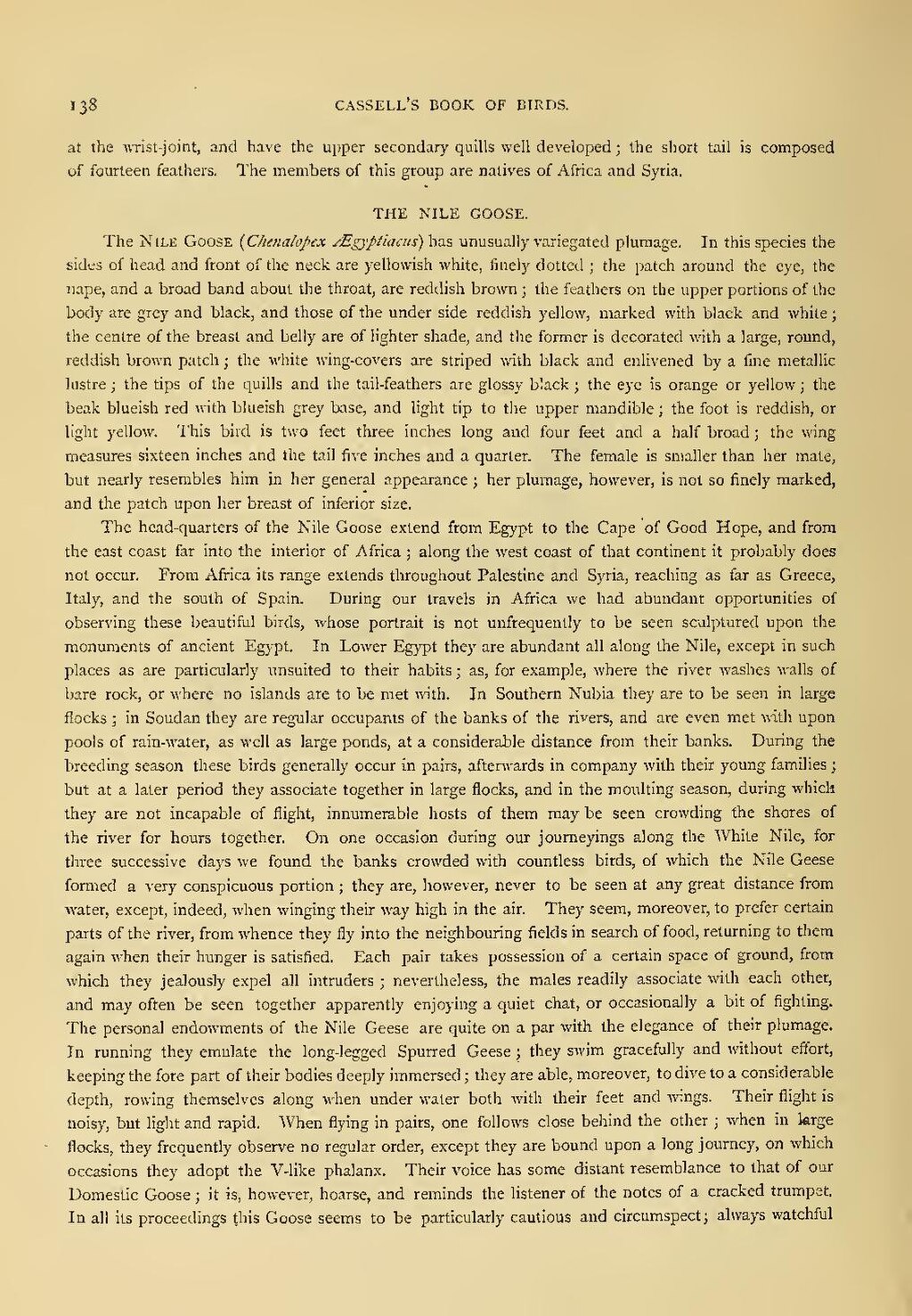at the wrist-joint, and have the upper secondary quills well developed; the short tail is composed of fourteen feathers. The members of this group are natives of Africa and Syria.
THE NILE GOOSE.
The Nile Goose (Chenalopex Ægyptiacus) has unusually variegated plumage. In this species the sides of head and front of the neck are yellowish white, finely dotted; the patch around the eye, the nape, and a broad band about the throat, are reddish brown; the feathers on the upper portions of the body are grey and black, and those of the under side reddish yellow, marked with black and white; the centre of the breast and belly are of lighter shade, and the former is decorated with a large, round, reddish brown patch; the white wing-covers are striped with black and enlivened by a fine metallic lustre; the tips of the quills and the tail-feathers are glossy black; the eye is orange or yellow; the beak blueish red with blueish grey base, and light tip to the upper mandible; the foot is reddish, or light yellow. This bird is two feet three inches long and four feet and a half broad; the wing measures sixteen inches and the tail five inches and a quarter. The female is smaller than her mate, but nearly resembles him in her general appearance; her plumage, however, is not so finely marked, and the patch upon her breast of inferior size.
The head-quarters of the Nile Goose extend from Egypt to the Cape of Good Hope, and from the east coast far into the interior of Africa; along the west coast of that continent it probably does not occur. From Africa its range extends throughout Palestine and Syria, reaching as far as Greece, Italy, and the south of Spain. During our travels in Africa we had abundant opportunities of observing these beautiful birds, whose portrait is not unfrequently to be seen sculptured upon the monuments of ancient Egypt. In Lower Egypt they are abundant all along the Nile, except in such places as are particularly unsuited to their habits; as, for example, where the river washes walls of bare rock, or where no islands are to be met with. In Southern Nubia they are to be seen in large flocks; in Soudan they are regular occupants of the banks of the rivers, and are even met with upon pools of rain-water, as well as large ponds, at a considerable distance from their banks. During the breeding season these birds generally occur in pairs, afterwards in company with their young families; but at a later period they associate together in large flocks, and in the moulting season, during which they are not incapable of flight, innumerable hosts of them may be seen crowding the shores of the river for hours together. On one occasion during our journeyings along the White Nile, for three successive days we found the banks crowded with countless birds, of which the Nile Geese formed a very conspicuous portion; they are, however, never to be seen at any great distance from water, except, indeed, when winging their way high in the air. They seem, moreover, to prefer certain parts of the river, from whence they fly into the neighbouring fields in search of food, returning to them again when their hunger is satisfied. Each pair takes possession of a certain space of ground, from which they jealously expel all intruders; nevertheless, the males readily associate with each other, and may often be seen together apparently enjoying a quiet chat, or occasionally a bit of fighting. The personal endowments of the Nile Geese are quite on a par with the elegance of their plumage. In running they emulate the long-legged Spurred Geese; they swim gracefully and without effort, keeping the fore part of their bodies deeply immersed; they are able, moreover, to dive to a considerable depth, rowing themselves along when under water both with their feet and wings. Their flight is noisy, but light and rapid. When flying in pairs, one follows close behind the other; when in large flocks, they frequently observe no regular order, except they are bound upon a long journey, on which occasions they adopt the V-like phalanx. Their voice has some distant resemblance to that of our Domestic Goose; it is, however, hoarse, and reminds the listener of the notes of a cracked trumpet. In all its proceedings this Goose seems to be particularly cautious and circumspect; always watchful
